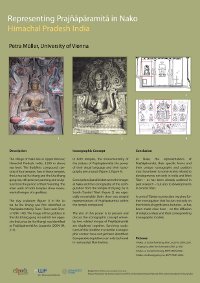| Author | Petra Müller |
| Title | Representing Prajñāpāramitā in Nako - Himachal Pradesh India |
Abstract
Description: The village of Nako lies in Upper Kinnaur, Himachal Pradesh, India, 3.550 m above sea level. The Buddhist compound is comprised of four temples. Two of these temples, the Lo tsa ba lha khang and the Lha khang gong ma, still preserve painting and sculpture from the period of their founding. The main walls of both temples show monumental images of a goddess. The clay sculpture (figure 1) in the Lo tsa ba lha khang was first identified as Prajñāpāramitā by Tucci (Tucci and Ghersi 1934: 146). The image of the goddess in the Lha khang gong ma (which lies opposite the Lo tsa ba lha khang) was identified as Prajñāpāramitā by Luzanits (2004: 84, 215).
Iconographic Concept:In both temples, the monumentality of the statues of Prajñāpāramitā, the power of their visual language and their iconography are unusual (figure 3, figure 4). Conceptional parallels between the images at Nako and the iconography of the configuration from the temple of rKyang bu in South-/Central Tibet (figure 2) are especially remarkable. Both show two representations of Prajñāpāramitā within the temple compound. The aim of this poster is to present and discuss the iconographic concept whereby two images of Prajñāpāramitā are displayed together. Surviving sculptures of this Goddess in a similar iconographic context have not yet been identified. Comparable depictions can only be found in manuscript illumination.
